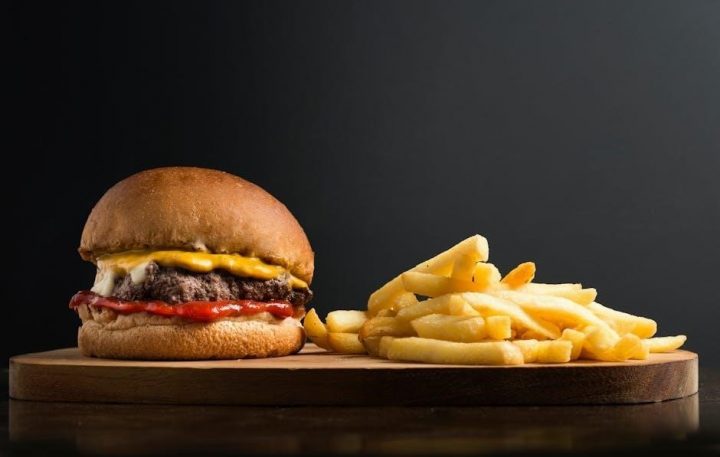A 1400 calorie meal plan is a structured dietary approach designed for weight loss, offering balanced meals with breakfast, lunch, dinner, and snacks. It focuses on portion control, hydration, and nutrient-rich foods to support overall health and steady weight reduction.
1.1 What is a 1400 Calorie Meal Plan?
A 1400 calorie meal plan is a dietary regimen designed to provide approximately 1400 calories per day, structured around balanced meals. It typically includes breakfast, lunch, dinner, and snacks, focusing on nutrient-dense foods to support weight loss and overall health. This plan is often tailored to individual needs, offering variations such as low-carb or culturally specific options, like Indian cuisine. It emphasizes portion control and hydration, making it a comprehensive approach for those aiming to manage their weight effectively.
1.2 Benefits of a 1400 Calorie Meal Plan
A 1400 calorie meal plan offers numerous benefits, including steady weight loss, improved metabolic health, and enhanced nutrient intake. It promotes balanced nutrition, ensuring adequate protein, healthy fats, and complex carbohydrates. This plan also encourages portion control and mindful eating, helping to reduce hunger and cravings. Additionally, it supports overall well-being by providing structured meals that cater to diverse dietary needs, such as low-carb or Indian cuisine preferences. Regular hydration is also emphasized, further aiding in weight management and digestion.
1.3 Who Can Benefit from a 1400 Calorie Meal Plan?
Individuals aiming to lose 10-20 pounds, those with a small stature, or those with lower physical activity levels can benefit. It suits people with type 2 diabetes or pre-diabetes due to balanced meals. Vegetarians and vegans can adapt the plan to their preferences. This calorie intake is ideal for maintaining weight loss progress without extreme restriction. Professional guidance is recommended to ensure it meets personal health goals and dietary needs effectively.

Structure of the 1400 Calorie Meal Plan
The 1400 calorie meal plan is organized into breakfast, lunch, dinner, and snacks, ensuring balanced nutrition and steady energy levels throughout the day for effective weight loss.
2.1 Daily Meal Breakdown
The 1400 calorie meal plan is structured into three main meals and one or two snacks, ensuring a balanced distribution of calories and nutrients. Breakfast typically ranges from 250-300 calories, focusing on protein-rich options like eggs or Greek yogurt. Lunch and dinner are around 300-400 calories each, incorporating lean proteins, whole grains, and vegetables. Snacks are kept light, around 100-150 calories, often featuring fruits or nuts. This breakdown ensures steady energy levels and prevents excessive hunger, supporting weight loss goals effectively.
2.2 Balanced Nutrition in Each Meal
A 1400 calorie meal plan emphasizes balanced nutrition by distributing macronutrients evenly across meals. Protein sources like lean meats, fish, or legumes are included to support muscle health and satiety. Complex carbohydrates, such as whole grains, fruits, and vegetables, provide sustained energy. Healthy fats from nuts, seeds, or avocados are incorporated for essential fatty acids. Each meal also includes a variety of vitamins and minerals, ensuring overall nutritional adequacy while staying within the calorie limit for effective weight management and improved health outcomes.
2.3 Importance of Macronutrient Distribution
Macronutrient distribution is crucial in a 1400 calorie meal plan to ensure optimal energy, satisfaction, and health benefits. Carbohydrates provide energy, proteins support muscle repair, and fats aid in hormone production. A balanced mix helps maintain metabolism, prevents nutrient deficiencies, and supports weight loss. Proper distribution also aids in managing hunger and cravings, making the diet sustainable. This approach ensures each meal is nutritionally complete, promoting overall well-being while adhering to the calorie goal.
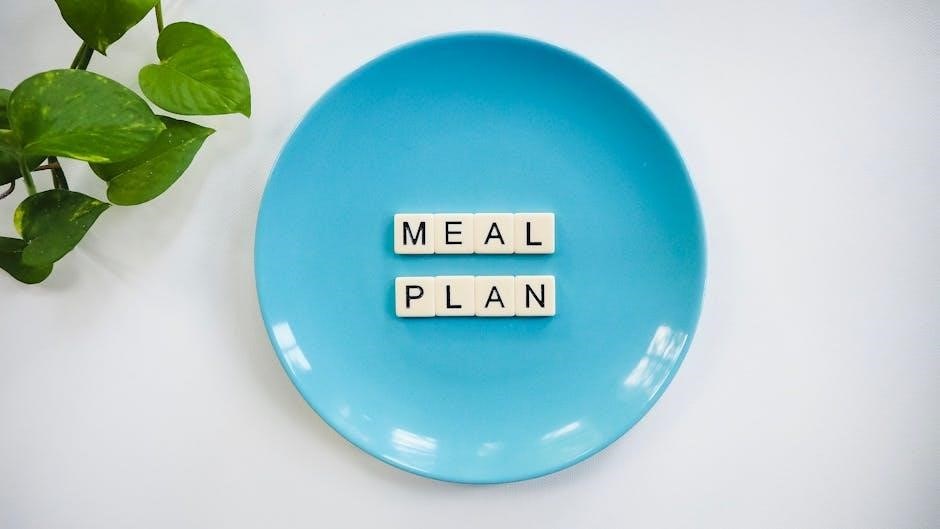
Sample 7-Day Meal Plan
A sample 7-day meal plan offers a structured approach with daily meals and snacks, ensuring balanced nutrition and variety to support weight loss goals effectively.
3.1 Monday: Breakfast, Lunch, Dinner, and Snacks
Start your week with a balanced breakfast of oatmeal topped with berries and almonds (250 calories). For lunch, enjoy grilled chicken breast with steamed vegetables and quinoa (350 calories). Dinner features baked salmon with asparagus and brown rice (300 calories). Snacks include a mid-morning Greek yogurt with honey (100 calories) and an evening handful of mixed nuts (100 calories). This day’s meals are designed to provide sustained energy and nutrient balance, totaling 1400 calories.
3.2 Tuesday: Meal Variations and Calorie Count
Breakfast includes scrambled eggs with spinach and whole-grain toast (220 calories). Lunch features a grilled chicken salad with mixed greens, cherry tomatoes, and a light vinaigrette (320 calories). For dinner, enjoy baked cod with roasted sweet potatoes and green beans (280 calories). Snacks include a mid-morning apple with peanut butter (120 calories) and an evening carrot sticks with hummus (100 calories). This day’s meals provide variety while maintaining a balanced 1400-calorie intake.
3.3 Wednesday: Incorporating Protein and Fiber
Breakfast: Greek yogurt with mixed berries and chia seeds (200 calories). Lunch: Grilled chicken breast with quinoa and steamed broccoli (300 calories). Dinner: Baked salmon with asparagus and sweet potato mash (280 calories). Snacks: A handful of almonds (100 calories) and a small apple with almond butter (120 calories). This day emphasizes high-protein and high-fiber foods to keep you full and energized, totaling 1400 calories.
3.4 Thursday: Low-Carb Options
Breakfast: Scrambled eggs with spinach, avocado slices, and a sprinkle of feta cheese (180 calories). Lunch: Grilled chicken breast with a mix of greens, cucumber, and olive oil dressing (250 calories). Dinner: Baked cod with roasted Brussels sprouts and cauliflower rice (260 calories). Snacks: Celery sticks with almond butter (100 calories) and a small handful of walnuts (120 calories). This low-carb day focuses on lean proteins and vegetables, keeping carbs minimal while staying within the 1400 calorie limit.
3.5 Friday: Balanced Meals for Weight Loss
Breakfast: Greek yogurt with mixed berries and a sprinkle of granola (200 calories). Lunch: Grilled chicken salad with mixed greens, cherry tomatoes, and balsamic vinaigrette (300 calories). Dinner: Baked salmon with roasted sweet potatoes and steamed green beans (320 calories). Snacks: Apple slices with peanut butter (120 calories) and a small piece of dark chocolate (100 calories). This day emphasizes nutrient-dense meals, ensuring balanced nutrition while supporting weight loss goals within the 1400 calorie limit.
3.6 Saturday: Weekend Meal Ideas
Breakfast: Oatmeal with sliced banana, almonds, and a drizzle of honey (250 calories). Lunch: Grilled chicken wrap with whole wheat tortilla, lettuce, and hummus (350 calories). Dinner: Baked cod with quinoa and sautéed spinach (300 calories). Snacks: A handful of mixed nuts (120 calories) and fresh fruit salad (100 calories). This day focuses on satisfying yet light meals, perfect for a relaxing weekend while staying within the 1400 calorie goal.
3.7 Sunday: Meal Preparations for the Week
Sunday is ideal for meal prepping to ensure a smooth week ahead; Cook proteins like grilled chicken or fish, portion them, and store in airtight containers. Chop vegetables for salads and snacks, and prepare overnight oats or yogurt parfaits for quick breakfasts. Pack meals in labeled containers with calorie counts for easy tracking. This organization helps maintain consistency and reduces the likelihood of deviating from the 1400 calorie plan. Prepping also saves time during busy weekdays.
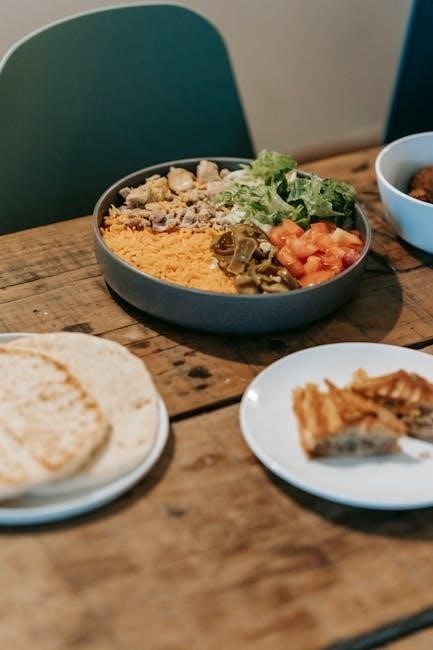
Customizing the Meal Plan
Customizing the 1400 calorie meal plan involves tailoring it to individual preferences, health goals, and lifestyle, ensuring flexibility while maintaining nutritional balance and calorie control effectively.
4.1 Adjusting for Individual Caloric Needs
Adjusting the 1400 calorie meal plan for individual caloric needs involves tailoring portion sizes and macronutrient distribution based on factors like age, weight, and activity level. For example, someone with a higher metabolism may require slightly more calories, while others might need fewer. The plan can be modified by adding or reducing specific food portions, ensuring the overall calorie intake remains balanced. A PDF meal plan provides a structured yet flexible framework to make these adjustments seamlessly, catering to diverse health goals and lifestyles effectively.
4.2 Incorporating Cultural and Dietary Preferences
The 1400 calorie meal plan can be tailored to incorporate cultural and dietary preferences by substituting ingredients and adjusting recipes. For example, someone following a vegetarian diet can replace meat with plant-based proteins like beans or tofu. Similarly, individuals with gluten intolerance can opt for gluten-free alternatives. The PDF format offers a structured yet flexible guide, allowing users to maintain their cultural cuisine while adhering to calorie goals. This adaptability ensures the meal plan is both enjoyable and effective for diverse lifestyles and preferences.
4.3 Vegetarian and Vegan Options
A 1400 calorie meal plan can easily accommodate vegetarian and vegan diets by focusing on plant-based proteins and nutrient-dense foods. Options like lentils, chickpeas, tofu, and tempeh provide ample protein, while whole grains, fruits, and vegetables ensure balanced nutrition. Vegan alternatives to dairy, such as almond or oat milk, can be incorporated seamlessly. The PDF format allows for clear organization of these options, making it simple to plan and stick to a plant-based diet while maintaining calorie goals and nutritional needs.
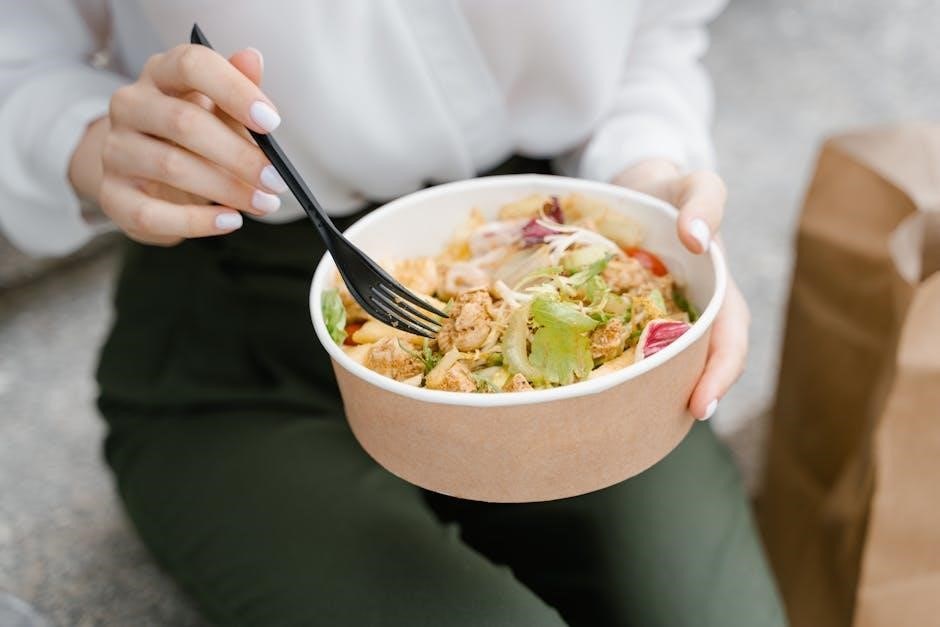
Benefits of Using a PDF Meal Plan
A PDF meal plan offers an organized, easy-to-follow structure with clear calorie counts and nutritional information. It’s shareable, printable, and serves as a handy reference for tracking progress and consulting with healthcare professionals.
5.1 Convenience and Portability
A 1400 calorie meal plan PDF is highly convenient, allowing users to access their diet plan anytime, anywhere. It can be easily downloaded and viewed on smartphones, tablets, or computers, making it portable for on-the-go reference. The PDF format ensures that the layout remains consistent and professional, with clear sections for meals and snacks. Additionally, it can be printed, offering a physical copy for meal prepping or sharing with nutritionists. This portability and accessibility make sticking to the plan simpler and more sustainable.
5.2 Easy Tracking and Monitoring
A 1400 calorie meal plan PDF simplifies tracking and monitoring by providing a clear, organized structure. Each meal and snack is detailed with portion sizes and calorie counts, making it easy to stay on track. Users can check off meals as they go, ensuring accountability. The PDF also allows for notes and adjustments, helping individuals monitor their progress and make necessary changes. This feature aids in maintaining consistency and achieving long-term weight management goals effectively.
5.3 Professional and Structured Layout
The 1400 calorie meal plan PDF features a professional and structured layout, enhancing user experience. Each day is neatly organized with breakfast, lunch, dinner, and snacks clearly separated. Bold headings, bullet points, and color-coded sections make the plan visually appealing and easy to follow. The structured format ensures meals are balanced and varied, while the professional design motivates users to stick to their diet. This layout is ideal for those seeking a clear, user-friendly guide to weight loss and healthy eating.

Tips for Success with the 1400 Calorie Meal Plan
Staying hydrated, portion control, and regular physical activity are essential. Prioritize whole foods, track progress, and practice mindful eating to achieve sustainable weight loss.
6.1 Staying Hydrated
Drinking plenty of water is crucial for metabolism and appetite control. Aim for at least 8 glasses of water daily, or 2 liters. Incorporate herbal teas or infused water for variety. Avoid sugary drinks to prevent extra calories. Staying hydrated helps reduce hunger and boosts energy levels, making it easier to stick to your meal plan. Tracking water intake alongside meals can also improve adherence to the 1400 calorie diet.
6.2 Portion Control and Measurement
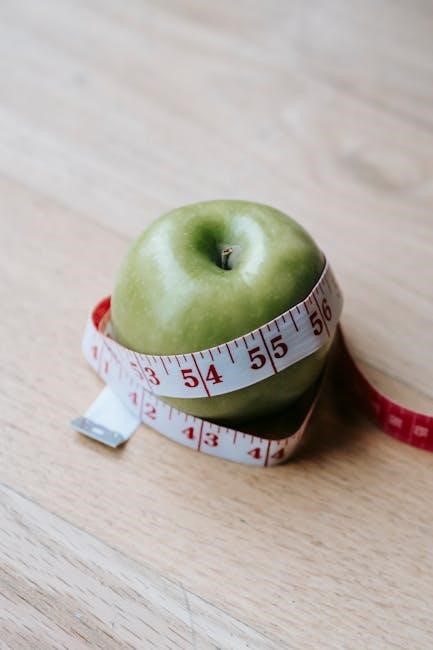
Accurate portion control is vital for adhering to the 1400 calorie meal plan. Use measuring cups or a food scale to gauge serving sizes. Understanding proper portions ensures you stay within daily calorie limits while maintaining balanced nutrition. Divide meals into protein, vegetables, and whole grains, adjusting portions based on hunger and activity levels. Avoid eating straight from packages to prevent overeating. Tracking portions helps maintain consistency and supports long-term weight management goals effectively.
6.3 Incorporating Physical Activity
Incorporating physical activity into your daily routine enhances the effectiveness of the 1400 calorie meal plan. Aim for at least 150 minutes of moderate-intensity exercise or 75 minutes of vigorous exercise weekly. Strength training and high-intensity interval training (HIIT) can also boost metabolism and burn calories. Physical activity not only supports weight loss but also improves overall health, reduces stress, and increases energy levels. Combining exercise with a balanced diet creates a calorie deficit, essential for achieving and maintaining weight loss goals effectively.
6.4 Mindful Eating Practices
Mindful eating is a powerful tool to enhance your 1400 calorie meal plan. It involves savoring each bite, paying attention to flavors, and eating slowly. This practice helps you recognize hunger and fullness cues, preventing overeating. Avoid distractions like TV or phones during meals to stay focused on your food. Mindful eating fosters a healthier relationship with food, making meals more satisfying and reducing cravings. It also helps you enjoy portion-controlled meals without feeling deprived, supporting long-term weight management and overall well-being.

Common Challenges and Solutions
Challenges like hunger, cravings, and motivation are common. Solutions include meal prepping, staying hydrated, and seeking support to maintain consistency and achieve goals effectively.
7.1 Dealing with Hunger and Cravings
Hunger and cravings are common challenges on a 1400 calorie meal plan. To address this, incorporate protein-rich meals, healthy snacks like nuts or fruits, and fiber-rich foods to keep you full. Staying hydrated by drinking water can also reduce hunger pangs. Plan meals in advance to avoid temptation and ensure nutrient-dense options are readily available. Mindful eating practices, such as savoring each bite, can help curb unnecessary cravings and support long-term success.
7.2 Maintaining Motivation
Maintaining motivation on a 1400 calorie meal plan requires setting realistic goals and celebrating small achievements. Track progress through journals or apps to visualize success. Surround yourself with a supportive community to share experiences and gain encouragement. Reward yourself with non-food treats, like new workout gear, to stay motivated. Remind yourself of the long-term benefits, such as improved health and energy levels, to keep focus. Consistency and patience are key to achieving lasting results.
7.3 Avoiding Plateaus
Avoiding plateaus on a 1400 calorie meal plan involves mixing up your routine. Incorporate strength training or high-intensity interval training to boost metabolism. Rotate meal options to keep your diet varied and prevent your body from adapting. Consider intermittent fasting or adjusting portion sizes temporarily. Track progress weekly and make subtle changes if weight loss stalls. Stay consistent, as plateaus are temporary, and celebrate small victories to maintain momentum and motivation throughout your journey.
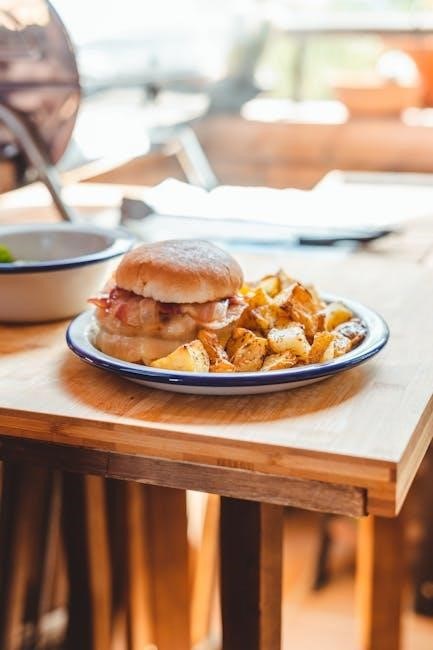
Nutritional Considerations
A 1400 calorie meal plan requires careful attention to balanced macronutrients, ensuring adequate protein, healthy fats, and complex carbs. Prioritize whole foods rich in vitamins, minerals, and fiber to support overall health and energy levels.
8.1 Protein Requirements
Ensuring adequate protein intake is vital in a 1400-calorie meal plan, typically requiring 60-80 grams daily. Protein supports muscle maintenance, satiety, and metabolic function. Include lean sources like chicken, fish, tofu, eggs, and legumes. Aim for 20-30 grams per meal and 10-15 grams in snacks; Plant-based options are equally effective, making it suitable for vegetarians and vegans. Proper protein distribution helps prevent muscle loss and keeps energy levels stable throughout the day.
8.2 Healthy Fats and Carbohydrates
A 1400-calorie meal plan should include healthy fats and complex carbs for balanced nutrition. Sources like avocados, nuts, and olive oil provide essential fatty acids, supporting heart health and satiety. Carbohydrates, such as whole grains, fruits, and vegetables, offer energy and fiber. Aim for 45-60% of calories from carbs and 20-30% from fats. Avoid refined sugars and opt for whole, unprocessed foods to maintain steady energy levels and overall nutritional balance.
8.3 Importance of Fiber
Fiber plays a crucial role in a 1400-calorie meal plan, promoting satiety and aiding digestion. It helps regulate blood sugar levels and supports healthy gut bacteria. Aim for 25-30 grams daily from sources like fruits, vegetables, whole grains, and legumes. Fiber-rich meals reduce hunger and cravings, making weight loss easier. It also supports heart health by lowering cholesterol and improving overall nutrient absorption. Incorporating fiber ensures a balanced diet and long-term health benefits, making it essential for sustainable weight management and well-being.
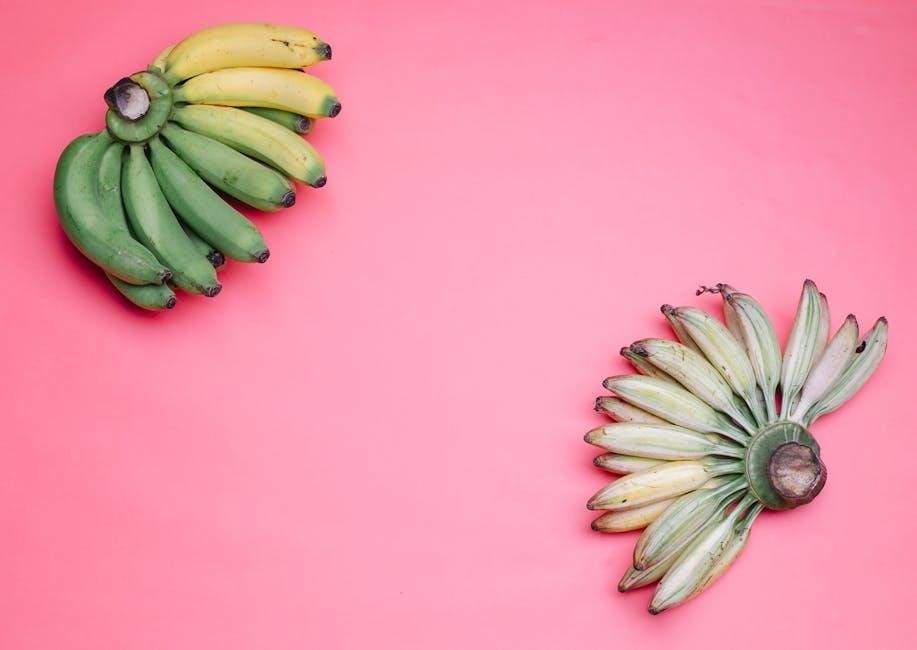
Meal Plan for Specific Diets
A 1400-calorie meal plan can be tailored to suit various dietary preferences, ensuring balanced nutrition while catering to low-carb, keto, vegetarian, or cultural-specific requirements effectively and deliciously.
9.1 Low-Carb Meal Plan
A low-carb 1400-calorie meal plan focuses on reducing carbohydrate intake while emphasizing protein and healthy fats. It typically includes meals with lean meats, fish, eggs, and low-carb vegetables. Breakfast might feature scrambled eggs with spinach, while lunch could include grilled chicken salad. Dinner options often involve seafood or meat with cauliflower rice. Snacks like nuts or cheese are allowed in moderation. This plan helps manage blood sugar levels and supports weight loss by minimizing carb cravings and promoting satiety.
9.2 Keto Meal Plan
A 1400-calorie keto meal plan emphasizes high-fat, low-carbohydrate foods to induce ketosis, optimizing fat burning. Meals include fatty meats, eggs, full-fat dairy, oils, and low-carb vegetables. Breakfast might be scrambled eggs with avocado, while lunch could feature grilled salmon with cauliflower rice. Dinner options include beef stir-fries with zucchini noodles. Snacks like cheese or nuts are allowed. This plan supports significant weight loss and improved energy levels by minimizing carb intake and maximizing fat utilization, aligning with ketogenic principles.
9.3 Indian Diet Plan
A 1400-calorie Indian diet plan incorporates traditional dishes with a focus on balanced nutrition. Breakfast options like moong dal chilla or oats upma are nutritious and low-calorie. Lunch includes small portions of brown rice, mixed vegetables, and dal. Snacks like roasted chana or fruits keep energy levels steady. Dinner features vegetable biryani with brown rice and a side salad. This plan emphasizes whole grains, legumes, and spices, ensuring cultural preferences are met while supporting sustainable weight loss and fiber-rich meals.
Adopting the 1400-calorie meal plan offers a balanced and structured approach to weight loss and overall health. Stay consistent to achieve long-term success and well-being.
10.1 Final Thoughts on the 1400 Calorie Meal Plan
The 1400-calorie meal plan is an effective and sustainable approach for weight loss and improved nutrition. It provides a structured framework, ensuring balanced meals while catering to individual calorie needs. By focusing on nutrient-dense foods and portion control, this plan helps achieve long-term health goals. Consistency and patience are key, as sustainable results require time. Always consult a professional to tailor the plan to your specific needs for the best outcomes.
10.2 Encouragement for Long-Term Success
Embrace the 1400-calorie meal plan as a journey toward healthier habits and sustainable weight loss. Celebrate small victories, like preparing balanced meals or resisting cravings, to stay motivated. Consistency is key, and tracking progress in your PDF plan can reinforce commitment; Remember, it’s not just about calories but nurturing your body with nutrient-rich foods. Stay patient, and let your dedication pave the way for long-term success and overall well-being.
